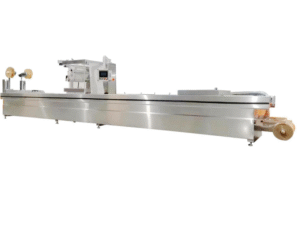What is the Best Way to Package Candy?
Table of Contents
Introduction
In the competitive confectionery industry, packaging plays a crucial role that extends far beyond simply containing the product. The right packaging protects candy from environmental factors, preserves freshness, attracts consumers, and communicates brand values. Whether you’re a small artisan candy maker or a large-scale manufacturer, understanding the best way to package candy is essential for product success and customer satisfaction.
This comprehensive guide explores the most effective candy packaging methods, materials, and technologies available today, helping you make informed decisions for your business.
Key Factors in Candy Packaging
When determining the best way to package candy, several critical factors must be considered. Product protection stands at the forefront, as candy is sensitive to moisture, temperature fluctuations, oxygen exposure, and physical damage. The packaging must create an effective barrier against these elements to maintain product quality and extend shelf life.
Visual appeal is equally important in the candy industry, where purchasing decisions are often impulse-driven. Eye-catching designs, vibrant colors, and transparent windows that showcase the product can significantly influence consumer choices. Additionally, functional considerations such as ease of opening, resealability, and portion control enhance the user experience and can build customer loyalty.
Cost-effectiveness must also be balanced with quality requirements. While premium packaging materials may offer superior protection and aesthetics, they must align with your product’s price point and target market expectations.
Choosing the Right Packaging Materials
The selection of packaging materials directly impacts candy preservation and presentation. Plastic films, including polypropylene and polyethylene, are widely used due to their excellent moisture barrier properties, flexibility, and cost-effectiveness. These materials are ideal for flow-wrapped candies, pillow packs, and flexible pouches.
Foil-based materials provide superior protection against light, oxygen, and moisture, making them perfect for chocolate and premium confections. Aluminum foil or metallized films not only preserve product freshness but also convey a sense of quality and luxury.
Paper-based packaging has gained popularity as consumers increasingly demand sustainable options. While traditional paper offers limited protection, modern laminated or coated papers can provide adequate barriers for many candy types while maintaining eco-friendly credentials.
For retail display, rigid containers such as boxes, jars, and tins offer excellent protection and premium presentation. These options work particularly well for gift assortments, seasonal products, and high-end confections.

The Automation Advantage: Candy Packaging Machines
For manufacturers seeking efficiency, consistency, and scalability, investing in a candy packaging machine represents a transformative solution. Modern packaging automation has revolutionized the confectionery industry, offering significant advantages over manual packaging methods.
A professional candy packaging machine delivers remarkable speed and precision, capable of packaging hundreds or even thousands of units per hour with consistent quality. This automation dramatically reduces labor costs while eliminating human error, ensuring each package meets exact specifications for weight, seal integrity, and appearance.
Various types of candy packaging machines cater to different needs. Flow wrap machines excel at creating horizontal pillow packs for individual candies or bars. Vertical form-fill-seal (VFFS) machines efficiently create bags from roll stock, fill them with candy, and seal them in one continuous operation. For hard candies, twist wrapping machines provide the classic wrapped appearance consumers recognize and love.
Multi-head weighers integrated with candy packaging machines ensure accurate portion control, critical for maintaining consistent product weight and complying with regulations. Modern machines also incorporate quality control features such as metal detection, checkweighers, and vision systems to identify defects before products reach consumers.
Types of Candy Packaging Methods
Flow wrapping remains one of the most versatile and widely used methods for candy packaging. This technique creates a hermetically sealed package by wrapping a continuous film around the product, making it ideal for individual candies, bars, and multi-packs. The method offers excellent product visibility and can accommodate various candy shapes and sizes.
Pillow bags provide a cost-effective solution for bulk candy packaging. Created by vertical or horizontal form-fill-seal machines, these packages are efficient for high-volume production and work well for both individual servings and larger quantities.
Stand-up pouches have gained significant market share due to their shelf presence and convenience features. With resealable zippers and flat bottoms for stability, these packages are perfect for sharing sizes and premium candy products. The large printable surface area also offers excellent branding opportunities.
Thermoformed packaging, including blister packs and clamshells, provides maximum product visibility and protection. This method is particularly suitable for premium chocolates, candy assortments, and products requiring individual compartments.
Sustainability in Candy Packaging
Environmental consciousness has become a non-negotiable consideration in modern candy packaging. Consumers increasingly prefer brands that demonstrate commitment to sustainability, making eco-friendly packaging both an ethical choice and a competitive advantage.
Recyclable materials should be prioritized whenever possible. Mono-material packaging, which uses a single type of plastic, simplifies recycling processes and increases the likelihood that packaging will be properly recycled. Clear labeling with recycling instructions helps consumers dispose of packaging responsibly.
Biodegradable and compostable options made from plant-based materials offer promising alternatives to traditional plastics. While these materials may have different performance characteristics, continuous innovation is expanding their applicability in candy packaging.
Source reduction strategies, such as lightweighting materials and optimizing package sizes, reduce environmental impact without compromising protection. A well-designed candy packaging machine can work with thinner films while maintaining seal integrity, contributing to sustainability goals.
Best Practices for Optimal Candy Packaging
Implementing best practices ensures your candy packaging meets quality standards and delights customers. Temperature control during packaging is crucial, especially for chocolate and temperature-sensitive candies. Packaging should occur in climate-controlled environments to prevent moisture condensation and maintain product integrity.
Hygiene standards must be maintained throughout the packaging process. All equipment, including your candy packaging machine, should be regularly cleaned and sanitized. Staff should follow strict hygiene protocols, including proper handwashing and wearing appropriate protective equipment.
Quality assurance testing should be conducted regularly to verify seal strength, package integrity, and barrier properties. This includes performing seal strength tests, leak detection, and accelerated aging studies to ensure packaging performs as intended throughout the product’s shelf life.
Compliance with regulations is non-negotiable. Ensure all packaging materials are food-grade certified and meet relevant safety standards. Labeling must include required nutritional information, ingredient lists, allergen warnings, and any necessary certifications.
Regular maintenance of packaging equipment prevents breakdowns and ensures consistent output quality. A well-maintained candy packaging machine operates more efficiently, produces less waste, and delivers better return on investment over its lifetime.

Conclusion
The best way to package candy involves a thoughtful combination of appropriate materials, effective methods, and reliable equipment. While small-scale operations might begin with manual packaging, growth and efficiency demands typically lead to automation through professional candy packaging machines.
By considering product protection, visual appeal, functionality, sustainability, and cost-effectiveness, you can develop a packaging strategy that preserves candy quality, attracts consumers, and supports your business objectives. As consumer preferences and technologies continue to evolve, staying informed about packaging innovations ensures your products remain competitive in the dynamic confectionery marketplace.
Investing in the right packaging solution today positions your candy business for long-term success, customer satisfaction, and sustainable growth.
Partner with the Experts
We are a professional candy packaging machine manufacturer with years of experience helping confectionery businesses achieve optimal packaging solutions. Our advanced machinery delivers reliability, efficiency, and exceptional quality to meet your production needs. Contact us today to discover how our candy packaging machines can transform your operations and elevate your product presentation.
